European Mars Lander Crashed Due to Data Glitch, ESA Concludes

The reason Europe's Schiaparelli Mars lander failed to touch down safely last fall is that conflicting data confused the craft's onboard computer, according to the newly completed crash investigation.
Things started to go wrong for Schiaparelli about 3 minutes after it hit the Martian atmosphere on Oct. 19, 2016. At that time, the lander deployed its parachute and then began spinning unexpectedly fast, according to the investigation, which concluded last week.
This superfast rotation briefly saturated Schiaparelli's spin-measuring instrument, which "resulted in a large attitude-estimation error by the guidance, navigation and control-system software," European Space Agency (ESA) officials wrote in a statement Wednesday (May 24). ("Attitude" refers to a spacecraft's orientation.) [In Photos: Europe's Schiaparelli Mars Landing Day]
"The incorrect attitude estimate, when combined with the later radar measurements, resulted in the computer calculating that it was below ground level," the officials added. "This resulted in the early release of the parachute and backshell, a brief firing of the thrusters for only 3 seconds instead of 30 seconds, and the activation of the on-ground system as if Schiaparelli had landed."
In reality, however, the lander was still about 2.3 miles (3.7 kilometers) up in the Martian sky, and falling fast. It ended up slamming into the red dirt at an estimated 335 mph (540 km/h), ESA officials said. The high-energy impact destroyed Schiaparelli and left a black scar that NASA's Mars Reconnaissance Orbiter was able to spot from space.
This scenario is consistent with ESA's preliminary crash-investigation results, which the agency released last November.
Schiaparelli launched in March 2016 along with the Trace Gas Orbiter (TGO). Together, the two craft made up the first part of the two-phase ExoMars program, a project led by ESA with Russia's federal space agency, Roscosmos, as the main partner.
Breaking space news, the latest updates on rocket launches, skywatching events and more!
TGO made it to orbit as planned in October 2016 and is now working its way toward its desired science orbit. When TGO gets there in early 2018, the orbiter will begin searching the Martian atmosphere for methane and other gases that could be signs of Red Planet life.
ExoMars' second phase centers on a life-hunting rover that's scheduled to launch in 2020. While Schiaparelli was equipped with a few science instruments, the lander's main job was to prove out the technology required to land the ExoMars rover safely.
That obviously didn't happen, but the crash and subsequent investigation have provided a great deal of useful information, ESA officials said.
"Interestingly, had the saturation not occurred and [had] the final stages of landing … been successful, we probably would not have identified the other weak spots that contributed to the mishap," ESA Director General Jan Woerner said in the ESA statement. "As a direct result of this inquiry, we have discovered the areas that require particular attention that will benefit the 2020 mission."
Such "weak spots" include computer models of parachute behavior and software that needs to be upgraded, ESA officials said.
The investigation team published its summary report on May 18. You can read it here: http://exploration.esa.int/mars/59176-exomars-2016-schiaparelli-anomaly-inquiry/
Follow Mike Wall on Twitter @michaeldwall and Google+. Follow us @Spacedotcom, Facebook or Google+. Originally published on Space.com.

Michael Wall is a Senior Space Writer with Space.com and joined the team in 2010. He primarily covers exoplanets, spaceflight and military space, but has been known to dabble in the space art beat. His book about the search for alien life, "Out There," was published on Nov. 13, 2018. Before becoming a science writer, Michael worked as a herpetologist and wildlife biologist. He has a Ph.D. in evolutionary biology from the University of Sydney, Australia, a bachelor's degree from the University of Arizona, and a graduate certificate in science writing from the University of California, Santa Cruz. To find out what his latest project is, you can follow Michael on Twitter.


